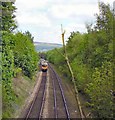
There is a bridge here which takes a minor road over the canal.
| Ashton Lock No 1W | 1¾ furlongs | |
| Ashton Lock Arm | 1¾ furlongs | |
| Minerva Road Bridge No 110 | 1¾ furlongs | |
| Bus Depot Bridge No 109 | 1¼ furlongs | |
| Texas Street Bridge No 108 | 1¼ furlongs | |
| Plantation Street Bridge No 107 | ||
| Plantation Lock No 2W | a few yards | |
| Tame Lock No 3W | ½ furlongs | |
| Clarence Street Bridge No 106 | 2 furlongs | |
| Tame Pipe Bridge | 3 furlongs | |
| Aqueduct over River Tame | 3¼ furlongs | |
According to information passed down through my family the mill building adjacent to the Plantation Street Bridge No 107 was originally the trans-shipment warehouse dating from the building of the canal and may predate Portland Basin.
The building originally trans-shipped cotton bales from the barges onto horse and cart which was then taken via toll roads to the first cotton mills in Ashton which were located at Cockbrook and Hurst Brook.
The toll road started on Plantation Street then travelled north as far as the valley side where it wound up to a toll house in Southampton Street known as Mabs Cottage. The toll road then continued north to Currier Lane where it divided into two. The right hand branch went east along Currier Lane and down to the mills at Throstle Bank, Cockbrook. The left hand branch went north west along Grafton Street then cross the fields to the cotton mills at Hurst brook.
In 1845 the toll road changed when the railway was built by the Ashton, Stalybridge and Liverpool Junction Railway. A bridge was built in Grafton Street and one in Currier Lane to carry the roads over the new railway tracks.
Around the same time a railway bridge was built in Southampton Street to carry the toll road over the Stalybridge extension of the Manchester, Lincolnshire and Ashton Railway.
A third railway line was built much later which carried the direct Guide Bridge underpass line from Stalybridge to Hooley Hill and Denton. This meant the winding toll road up from Plantation Street to the Toll House in Southampton Street had to be severed and diverted to the right so as to meet up with Granville Street which ran parallel to the east of Southampton Street. This also allowed for a much gentler gradient up the valley side to meet up with Currier Lane.
The trans-shipment warehouse, Plantation Street, Countess Street and the trans-shipment warehouse are still in their original condition, whilst the old toll road via Southampton Street is still traceable and has become a nature area.
There are indications that Tameside Local Authority, who care little for heritage, are considering a complete redevelopment of the area when much of this valuable industrial heritage will disappear for ever.
Information provided by David Dawson, Mabs Court, Ashton under Lyne who will be pleased to assist anyone interested.
Why not log in and add some (select "External websites" from the menu (sometimes this is under "Edit"))?
Mouseover for more information or show routes to facility
Nearest water point
In the direction of Ashton-under-Lyne Junction
In the direction of Aspley Basin (Huddersfield)
Nearest rubbish disposal
In the direction of Ashton-under-Lyne Junction
In the direction of Aspley Basin (Huddersfield)
Nearest chemical toilet disposal
In the direction of Ashton-under-Lyne Junction
In the direction of Aspley Basin (Huddersfield)
Nearest place to turn
In the direction of Ashton-under-Lyne Junction
In the direction of Aspley Basin (Huddersfield)
Nearest self-operated pump-out
In the direction of Ashton-under-Lyne Junction
In the direction of Aspley Basin (Huddersfield)
Nearest boatyard pump-out
In the direction of Ashton-under-Lyne Junction
There is no page on Wikipedia called “Plantation Street Bridge”































